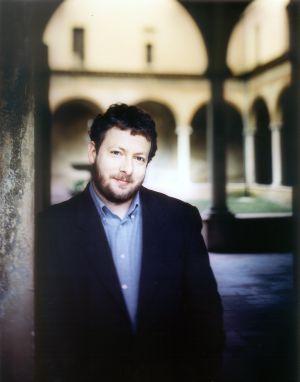| Available at Amazon: Antonio Vivaldi et al., Bajazet, Ildebrando d'Arcangelo, David Daniels, Patrizia Ciofi, Europa Galante, Fabio Biondi (released on May 10, 2005) |
The battle of the Ottoman emperor Bayezid I, who once boasted that his horse would use the Throne of St. Peter as its manger (an anecdote related by Gibbon in The History of the Decline and Fall of the Roman Empire), and the Tartar emperor Timur Lenk in 1402 has been recounted numerous times. Famously, Jean Racine made the story into a French classical tragedy (Bajazet, 1672), and not long after that operas were being staged that told versions of the final downfall of the arrogant sultan, usually titled either Bajazet or, as in the version that Handel created, Tamerlano. Stories of Bayezid's humiliation while he was Tamerlano's prisoner -- Tamerlano used him as a footstool, kept him caged like an animal, made his wife dance naked for his court -- and resultant suicide from despair are probably apocyphal, but they make for great drama. It is a strange twist of fate that in Italy, directly threatened by Bayezid I and the Ottomans, opera should largely depict him as a sympathetic figure.
Motezuma (August 2, 2006) Orlando furioso (May 31, 2005) |
The thought of identifying his own artistic fate with the political fate of the noble Bajazet, and the arrogance of the Neapolitan victors with that of the conquering Tartars, was too tempting for Vivaldi to resist, and he created in this pasticcio a kind of musical parable: all the arias for the strong-minded, loyal characters (Bajazet, Asteria, and the faithful Idaspe) are the work of Vivaldi himself, while the arias for the characters representing oppression (Tamerlano, Andronico, and Irene) are for the most part written by Neapolitan composers.
 If we follow that musical division, then I can begin with the startling performance of Ildebrando d'Arcangelo, who puts his remarkable bass-baritone into a Bajazet of extraordinary power and resonance. In the second act, he gives a riveting performance of the dramatic accompanied recitative "Odi, perfida," confronting his daughter Asteria. Most striking is the excellent rage aria "Dov'è la figlia" (borrowed from Vivaldi's own Motezuma), with a rafter-shaking high A. Marijana Mijanović brings her coffee-rich low range -- gorgeous but also light, almost countertenorish -- to the sweet little aria "La cervetta timidetta" in Act II (borrowed from Vivaldi's Giustino), with transparent continuo provided by harp. Soprano Patrizia Ciofi is ravishing in the small role of Idaspe, Andronico's friend. Her pure voice, not nearly colorless like Emma Kirkby, for example, but measured and scaled even when the part goes very high, as in the luscious "Nasce rosa lusinghiera" (Act I, recycled from Vivaldi's Farnace).
If we follow that musical division, then I can begin with the startling performance of Ildebrando d'Arcangelo, who puts his remarkable bass-baritone into a Bajazet of extraordinary power and resonance. In the second act, he gives a riveting performance of the dramatic accompanied recitative "Odi, perfida," confronting his daughter Asteria. Most striking is the excellent rage aria "Dov'è la figlia" (borrowed from Vivaldi's own Motezuma), with a rafter-shaking high A. Marijana Mijanović brings her coffee-rich low range -- gorgeous but also light, almost countertenorish -- to the sweet little aria "La cervetta timidetta" in Act II (borrowed from Vivaldi's Giustino), with transparent continuo provided by harp. Soprano Patrizia Ciofi is ravishing in the small role of Idaspe, Andronico's friend. Her pure voice, not nearly colorless like Emma Kirkby, for example, but measured and scaled even when the part goes very high, as in the luscious "Nasce rosa lusinghiera" (Act I, recycled from Vivaldi's Farnace).As for the characters singing other other composers' music, David Daniels turns in another fine performance as Tamerlano. It is strange to modern ears that Vivaldi created the role of the conquering Tartar for a female singer, Maria-Maddalena Pieri, to be contrasted with the low part of Bajazet. Daniels is particularly good in the beautiful first-act aria "Vedeste mai sul prato," stolen from Hasse's Siroe Re di Persia. Mezzo-soprano Elina Garanča has a husky sound, not overburdened with active vibrato, as Andronico, Tamerlano's ally. She is evocative in the minor-mode "Quel ciglio vezzosetto" (Act I) and a little Marilyn on the low notes of "La sorte mia spietata," also stolen from Hasse's Siroe Re di Persia.
American mezzo-soprano Vivica Genaux is delicious as Irene, the princess betrothed to Tamerlano, especially on the role's most famous aria "Sposa, son disprezzata" (Act II, stolen from Giacomelli's Merope). Via YouTube above, you can see and hear a young Cecilia Bartoli sing that aria. Genaux's career is on the rise, and New York readers may have heard her as Juno/Ino in Handel's Semele at New York City Opera with Elizabeth Futral. I will be reviewing her next weekend when she joins Futral again as Neocle in Rossini's L'assedio di Corinto at Baltimore Opera. Next spring she will join another dream cast (Danielle de Niese, Sandrine Piau, Angelika Kirchschlager, Ildebrando D’Arcangelo) for performances of Handel's Ariodante with Christophe Rousset and Les Talens Lyriques. I hope they record that.
Right from the first track, the sinfonia announces the hearty and dynamic tone that Biondi and Europa Galante will maintain, alternating with delicate playing of impressive soavità, where the theorbo and strummed guitar shimmer through. Even the horns sound good. That sinfonia, a three-movement gem, should be played as much as the Seasons or other Vivaldi concerti, with which it has marked similarities. A bonus DVD, shot during the recording sessions, does not add anything to the cost of this 2-CD set and is an entertaining look behind the curtains. All around, this recording is highly recommended.
Virgin Classics 7243 5 45676 2 9
You Tube! Your first!
ReplyDelete